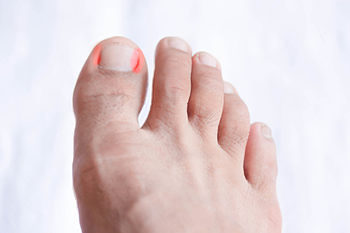
An ingrown toenail occurs when the edge of the nail grows into the surrounding skin, causing pain, redness, swelling, and sometimes infection. Soaking the foot in warm water with Epsom salts can help reduce inflammation and soften the nail. Keeping the foot clean and dry afterward is essential. Gently lifting the nail edge with a clean piece of cotton or dental floss may relieve pressure, but this should only be attempted in mild cases. Wearing tight shoes or socks can worsen the condition and should be avoided. Mild pain relievers may help with discomfort. If the area becomes increasingly red, warm, or begins to drain pus, these are signs of infection. Recurrent or severe ingrown toenails may require a minor in-office procedure to remove part of the nail or the nail root. If home care is not effective, it is suggested that you see a podiatrist for safe and lasting treatment.
Ingrown toenails can become painful if they are not treated properly. For more information about ingrown toenails, contact one our of podiatrists of The Foot and Ankle Specialists. Our doctors can provide the care you need to keep you pain-free and on your feet.
Ingrown Toenails
Ingrown toenails occur when a toenail grows sideways into the bed of the nail, causing pain, swelling, and possibly infection.
Causes
- Bacterial infections
- Improper nail cutting such as cutting it too short or not straight across
- Trauma to the toe, such as stubbing, which causes the nail to grow back irregularly
- Ill-fitting shoes that bunch the toes too close together
- Genetic predisposition
Prevention
Because ingrown toenails are not something found outside of shoe-wearing cultures, going barefoot as often as possible will decrease the likeliness of developing ingrown toenails. Wearing proper fitting shoes and using proper cutting techniques will also help decrease your risk of developing ingrown toenails.
Treatment
Ingrown toenails are a very treatable foot condition. In minor cases, soaking the affected area in salt or antibacterial soaps will not only help with the ingrown nail itself, but also help prevent any infections from occurring. In more severe cases, surgery is an option. In either case, speaking to your podiatrist about this condition will help you get a better understanding of specific treatment options that are right for you.
If you have any questions, please feel free to contact our offices located in Houston and Deer Park, TX . We offer the newest diagnostic and treatment technologies for all your foot care needs.
